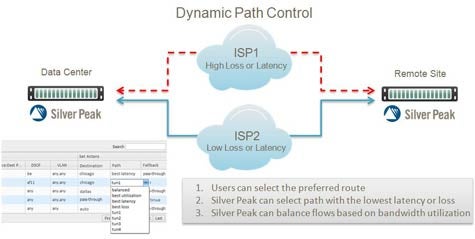Most IT organizations today have access to multiple types of wide area networks (WANs), which consist of everything from basic Internet connections to the most expensive MPLS service. What they don’t have is a lot of granular control over what WAN segment is being used by any particular application at any given time.
Silver Peak Systems today announced that it is providing that level of control in the form of a Dynamic Path Control capability that is now supported within the company’s WAN optimization platform. According to Damon Ennis, vice president of product management for Silver Peak, the Dynamic Path Control leverages the network intelligence that Silver Peak software already gathers to determine which WAN link has the best latency, lowest packet loss, and highest amount of available bandwidth at any given time. The Silver Peak Virtual Acceleration Open Architecture (VXOA) platform will then dynamically route traffic to that connection unless the IT organization has determined that a specific application needs to always use a particular WAN service.
Ennis says that since hybrid WAN services have become the norm, IT organizations need a way to allow hundreds of applications to leverage multiple services without any direct intervention on the part of the IT department. A dynamic provisioning capability based on the real-time performance attributes of the WAN service should lead to better application performance when enterprise applications are increasingly being distributed across multiple cloud computing environments.
At the moment, the dynamic provisioning service being provided by Silver Peak doesn’t take into account the cost of the WAN service being provided. But Ennis says this is something that Silver Peak expects to be able to incorporate as a factor in the future.
As the WAN continues to emerge as the linchpin for delivering cloud computing services, IT organizations of all sizes are now putting a lot more thought into how services are delivered across what is clearly the weakest link in the enterprise. The challenge is figuring out how to optimize those WAN services in a way that doesn’t require the IT organization to babysit every application that uses them.




